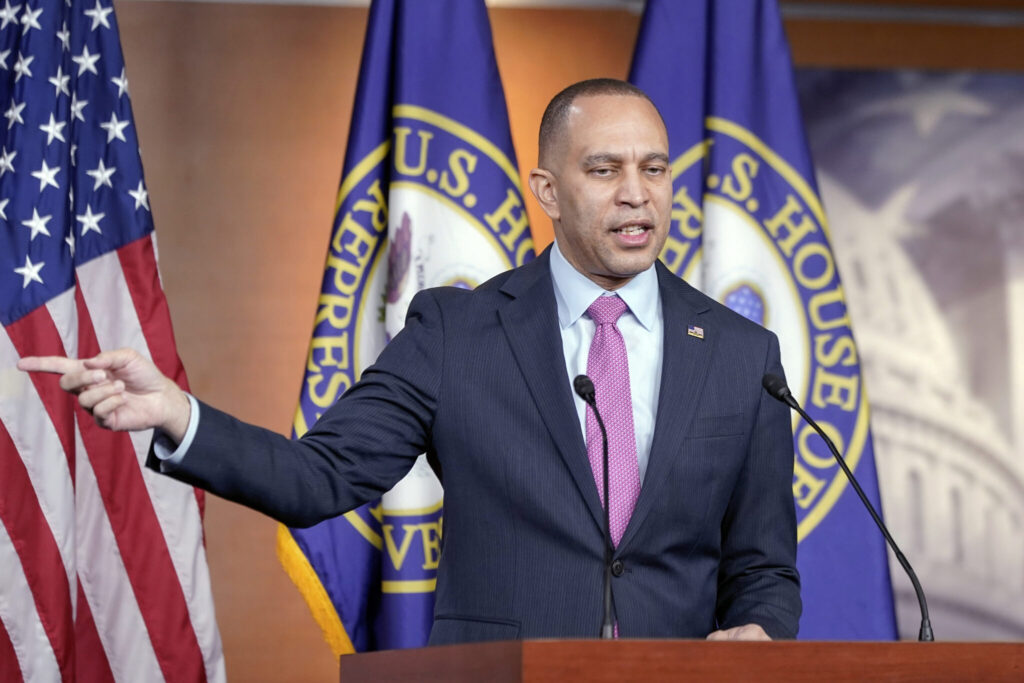Barely six months into the job, House Speaker Mike Johnson is already at risk of the same conservative revolt that took down his predecessor. The Louisiana Republican, who only took the gavel in October after weeks of GOP infighting, was put on “warning” by one of his harshest critics Friday after he helped push through a $1.2 trillion spending package with majority Democratic votes despite heavy criticism from his right flank.
Quick Read
- House Speaker Mike Johnson faces a potential conservative revolt, echoing the downfall of his predecessor, due to his support for a $1.2 trillion spending package passed with mainly Democratic votes.
- Rep. Marjorie Taylor Greene filed a motion to vacate, a procedural move to oust Johnson, marking it as a “warning” rather than an immediate action, with a decision pending post-recess.
- Johnson’s resignation would tighten the GOP’s slim House majority to 217-213, limiting room for internal dissent on party-line votes.
- The motion to vacate, historically a tool for accountability, was notably used last October to remove Kevin McCarthy, facilitated by a rule allowing any member to trigger the vote.
- The procedure for a motion to vacate involves introducing a privileged resolution, demanding a House floor vote within two legislative days, subject to potential procedural delays by either party.
- Greene’s initiative underscores intra-party tensions, with Johnson’s leadership already scrutinized for his approach to critical issues like Ukraine aid, challenging the party’s unity.
- The outcome of the motion remains uncertain, with some Republicans cautious about repeating the divisive spectacle that led to McCarthy’s ousting, potentially empowering Democrats.
- If Johnson is removed, the speaker pro tempore, designated from a list provided by the sitting speaker, would oversee the election of a new speaker, necessitating a majority vote among present members.
The Associated Press has the story:
What’s next as Speaker Johnson faces a motion to vacate from Marjorie Taylor Greene
Newslooks- WASHINGTON (AP) —
Barely six months into the job, House Speaker Mike Johnson is already at risk of the same conservative revolt that took down his predecessor. The Louisiana Republican, who only took the gavel in October after weeks of GOP infighting, was put on “warning” by one of his harshest critics Friday after he helped push through a $1.2 trillion spending package with majority Democratic votes despite heavy criticism from his right flank.
During the vote, Rep. Marjorie Taylor Greene, R-Ga., filed a resolution with the House clerk — called a motion to vacate — that would remove Johnson from office if approved by the House. And while Greene did not force the resolution to be taken up immediately, she told reporters she was laying the groundwork for consideration once the House returns from recess in two weeks.

“It’s more of a warning and a pink slip,” Greene said. She would not commit to a timeline for calling a vote, but added, “We’ve started the clock to start the process to elect a new speaker.”
In a statement, a spokesperson for Johnson defended the speaker and his record.
“Speaker Johnson always listens to the concerns of members, but is focused on governing,” Raj Shah said. “He will continue to push conservative legislation that secures our border, strengthens our national defense and demonstrates how we’ll grow our majority.”
Here’s what to know about how the House can remove a speaker and what’s ahead for Johnson:
WHAT IS A MOTION TO VACATE?
The current rules of the House allow for any single lawmaker — Democrat or Republican — to make a “motion to vacate the chair,” essentially a vote to oust the speaker through a privileged resolution.

The motion has existed for most of congressional history. But it had never been deployed successfully until last October when a rebel band of Republicans joined with Democrats to oustKevin McCarthy as speaker.
McCarthy’s stunning removal came, in part, as the result of the concessions he was forced to make to win the speaker’s gavel in the first place. Among the concessions was agreeing that a motion to vacate could be triggered by a single member — the threshold that historically has been the norm.

Proponents of allowing a single lawmaker to file the motion said it promotes accountability, noting its long history in the House. The tool was used memorably in 2015 against then-Speaker John Boehner when then-Rep. Mark Meadows of North Carolina, a Republican who later became Donald Trump’s White House chief of staff, introduced a resolution to declare the speaker’s office vacant. Two months later, Boehner announced he would be stepping down.
HOW DOES IT WORK?
At any point in time, a member of the House can introduce a privileged resolution — a designation that gives it priority over other measures — to declare the office of the speaker of the House of Representatives vacant.

Once the motion is introduced, the lawmaker can walk onto the House floor and request a vote. Such a request would force House leaders to schedule a vote on the resolution within two legislative days.
But there are procedural motions that members of either party could introduce to slow down or stop the process altogether. If those tactics were to fail, and the resolution came to the floor for a vote, it would take a simple majority of the House — 218 votes, when no seats are vacant — to remove the speaker, as happened to McCarthy in a 216-210 vote.
WHO IS TRYING TO OUST JOHNSON AND WHY?
The surprise maneuver by Greene marks a stunning turn of events for Johnson who has fought for months to navigate an increasingly fractured Republican conference, which has been operating in the majority effectively in name only since January 2023.
Republicans unanimously chose Johnson late last year to replace McCarthy after several candidates for the job failed to gain enough support. Johnson’s conservative bend was seen as a welcome departure by the most extreme members of his party who had accused McCarthy for years of being too moderate, including when he worked across the aisle last year to fund the government and raise the nation’s debt limit.

Greene, who became a McCarthy ally late in his tenure, has been skeptical of Johnson’s speakership from the beginning. While she criticized her fellow far-right colleagues for toppling McCarthy, she herself had warned Johnson for months that she would try to remove him in a similar fashion if he were to push ahead with a package to support Ukraine as it battles Russia’s invasion.
Johnson has so far refused to put a $95 billion Senate-passed national security package with Ukraine funding to a House vote, but he promised that funding Ukraine is the next priority now that government funding is resolved. The removal threat against him now puts any votes to help Ukraine in potential jeopardy and could also empower Democrats to make demands since their votes might be needed to save his job.
DOES A MOTION TO VACATE HAVE THE VOTES TO PASS?
It remains unclear what support Greene’s resolution would have if she called it up for a vote. Some of her colleagues, who voted to oust McCarthy, threw cold water on the idea, saying they were not ready to support a motion to vacate Johnson.
“I don’t think it’s the right time,” Rep. Tim Burchett, R-Tenn., told reporters Friday afternoon. He added that another attempt to remove a GOP speaker could result in a win for Democrats in an election year. “If we did it right now we’d elect (Democratic Leader) Hakeem Jeffries as speaker.”

Additionally, many Republicans in Congress were embarrassed by McCarthy’s removal as speaker, which exposed deep party divisions and infighting, which left their new majority unable to function for three weeks.
The night before Friday’s voting, Rep. Matt Gaetz, R, Fla., who introduced the motion to oust McCarthy, echoed those sentiments, warning against trying to oust Johnson.
“When I vacated the last one, I made a promise to the country that we would not end up with a Democrat speaker … I couldn’t make that promise again today,” Gaetz said.
IF JOHNSON IS OUSTED, WHAT WOULD HAPPEN NEXT?
The speaker of the House, under the rules of the chamber, is required to keep a list of individuals who can act as speaker pro tempore in the event a chair is vacated. The list, which is oddly written by the sitting speaker at any given time, remains with the House Clerk and would be made public if the speakership were vacant.
The first person on that list would be named speaker pro tempore and their first order of business would be to hold an election for a new speaker. That event requires the House to vote as many times as it takes for a candidate to receive the majority of those present and voting for speaker.
In the case of McCarthy, the role of speaker pro tem fell to his close confidant Rep. Patrick McHenry, R-N.C., the chair of the House Financial Services Committee. McHenry served in the role for three weeks as Republicans nominated and toppled three candidates until they were finally able to rally enough support around Johnson.







